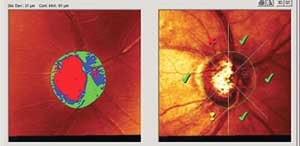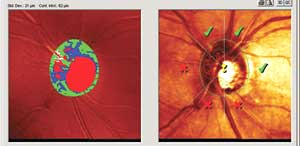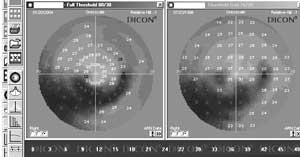ODs depend on newer technology for diagnosing, managing glaucoma
Click Here to Manage Email Alerts
Pachymetry, photodocumentation, visual field analysis and optic nerve imaging are just some of the technologies that primary care optometric practices should consider investing in to ensure that their glaucoma patients are properly diagnosed and managed.
John A. Gazaway, OD, who practices at Broadway Vision Clinic in Eagle Grove, Iowa, relies heavily on three devices: automated perimetry, pachymetry and optic nerve imaging. “Automated perimetry will show us if there is definite functional nerve damage,” Dr. Gazaway told Primary Care Optometry News in an interview. “The pachymetry will obviously show us the thickness of the cornea, so we can decide whether the pressure readings we are obtaining are reliable or not. Optic nerve imaging tells us if the nerve itself has characteristics of glaucomatous nerves.”
Dr. Gazaway considers these three technologies to be the standard of care and he typically performs all three tests on the first patient day. He also will repeat all three tests within the first 6 months, and then decide which tests need to be repeated more often than annually. “During the first year, I see most glaucoma patients once every 3 months,” Dr. Gazaway said. “On one of those visits, I may do field testing, then another time the imaging.”
The frequency of automated perimetry depends on the age of the patient and the degree of glaucomatous defects, according to Dr. Gazaway, who schedules one to three readings a year. A pachymetry test is normally scheduled three times over an 18-month period. “By that point, I’m usually satisfied that the readings are consistent,” Dr. Gazaway said. “If they are, I may never perform pachymetry again.”
Optic nerve imaging
Optic nerve imaging is performed in Dr. Gazaway’s practice usually two to three times within the first year. “After that, it will depend on the patient’s age and the degree of the defects of glaucoma,” he said.
He may schedule the testing twice a year thereafter. “Seldom do I perform the imaging test more than twice a year,” he said. “It’s more frequently done annually.”
Dr. Gazaway uses the Heidelberg Retinal Tomograph (HRT II, Heidelberg Engineering, Vista, Calif.) for optic nerve imaging. “I also have programs for the HRT3,” he said. “Not only do I feel the HRT gives me the most repeatable optic nerve head findings of any of the imaging instruments, but it now does a good job with the nerve fiber layer and other functions in addition to glaucoma.”
Dr. Gazaway has also found that insurance companies providing patient coverage in Iowa will pay for the various technologies, as long as they are documented as necessary by the practitioner. “Iowa pays pretty liberally,” he said, noting that he has encountered no difficulty being reimbursed for performing optic nerve imaging in end-stage glaucoma patients.
“However, if you perform these tests routinely more often than twice a year, you may be called upon to show documentation as to why,” he said.
Newer devices that scan and interpret the optic nerve and the retinal nerve fiber layer (RNFL) are most valuable to John A. McCall Jr., OD, who practices in Crockett, Texas. “The new scanning technologies allow us to detect glaucoma 7 to 9 years sooner than before,” he said in an interview. “This has made glaucoma treatment much more efficient. We are no longer guessing.”
Pieces of a puzzle
|
|
Dr. McCall tells his patients that glaucoma is like a thousand-piece puzzle. “You have to put almost all the pieces together before it begins to make a clear picture to you,” he said.
Pieces of the puzzle for Dr. McCall include applanation tonometry and pachymetry, as well as evaluation of the optic nerve and RNFL.
“For me, the most recent piece of the puzzle is new technology that measures tomography,” he said. This new technology is TonoPlus (Portable Ophthalmic Devices, Bettendorf, Iowa), which uses the tomography reading to calculate ocular blood flow to the back of the eye.
“Do we have good blood flow to the back of the eye or do we have very fragile blood flow to the back of the eye?” Dr. McCall said. “If I change a patient’s medication, I want to know how it affects both pressure and blood flow.”
Dr. McCall is also impressed with the Visante, which is optical coherence tomography (OCT) from Carl Zeiss Meditec, Dublin, Calif. “The Visante provides you with a wonderful image and cross-section of the anterior chamber of the eye,” he said. “You can actually measure the angle, right from the scleral spur. Hence, you can detect any iris bombe or some structural changes that would lead to difficult treatment of a glaucoma patient.”
Once Dr. McCall has a glaucoma suspect or a glaucoma patient, he usually performs an evaluation with one of three technologies: the GDx (Carl Zeiss Meditec) for measuring the RNFL, the HRT3 for measuring the dimensions of the optic nerve with a confocal scanning laser or the Stratus OCT (Carl Zeiss Meditec), which he uses primarily for retinal evaluation.
Combining technologies
“I don’t use all three of these imaging technologies on the same patient, but I frequently use the GDx and HRT3 on the same patient,” Dr. McCall said. “However, since these tests are reimbursed under the same CPT code, I am paid for doing only one of the tests, which is actually performed by technicians.”
Testing is scheduled once every 6 months for a strong glaucoma suspect or a glaucoma patient. The office also takes an ocular blood flow reading at each testing visit.
|
|
In general, insurers pay for testing every 6 months, according to Dr. McCall. “But it may vary from state to state,” he said.
“Of all the technologies, measuring RNFL is the most important to me for diagnosing glaucoma and for following glaucoma,” Dr. McCall said. “I also believe the GDx is easier than other technologies to identify subtle changes.”
Richard Noyes, OD, who is in private practice in Marion, Iowa, stressed the paradigm shift to structure and function when treating glaucoma patients. “We want to know how much tissue is present and we want to know how healthy that tissue is,” he told PCON. “Thus, we are doing a lot less treating by the seat of our pants, and a lot more treating with solid science behind it.”
Like others, Dr. Noyes believes that the imaging technologies in the form of the GDx, the OCT and the HRT “have opened tremendous pathways and moved us much earlier into the treatment curve, or at least earlier into the disease process, so that we are interceding at an earlier time.”
Documenting in microns
Optic nerve imaging for glaucoma is likely the most important technology for Dr. Noyes. “This has caused the biggest shift in our thinking and helps us clearly document in microns what is happening at the nerve fiber layer level,” he said. “In my practices, the two most important instruments have been the OCT and the GDx.”
Dr. Noyes also pointed out that pachymetry has become an integral component of the diagnostic work up, whereas pressure testing and fundus photography are “helpful addendums.”
Conversely, visual field analysis on earlier diagnosis “sometimes is not as helpful,” he said. “Most people have RNFL changes early in the course of the disease and visual field changes later.”
Dr. Noyes stated that visual field sensitivities and the smart logic that is now incorporated into visual field testing have made the test much more accurate. “The standard of care is clearly the Humphrey 750 (Carl Zeiss Meditec) visual field analyzer,” he said. “We also use the Humphrey Matrix (Carl Zeiss Meditec). As the disease advances, visual fields become increasingly important, because as the nerve fiber layer drops out, visual fields become a much more important indicator of change.”
|
Images: Broadway Vision Clinic |
Reliability concerns
Patients with suspected glaucoma should be scheduled for a visual field examination and RNFL imaging on the same day, Dr. Noyes said. “A visual field examination at best gives you a baseline to work from,” he said. “However, sometimes the reliability of the first, or first and second, or first, second and third test may not be good because of the patient’s learning curve.”
Likewise, imaging provides “a first-test impression as to whether the patient is likely to need treatment or not,” he said.
Although Dr. Noyes feels these two technologies “always rise to the top for sensitivity and specificity” and are the two most valuable tools for diagnosing and following glaucoma, “it is the concordance of the clinical appearance of the nerve head, the pressures, the pachymetry, the gonioscopy, the visual field and the GDx, as well as the family history, that will primarily lead me to treat or not treat a patient.”
The frequency of visual field testing is primarily guided by the patient’s presentation. “A typical glaucoma patient may have fields and retinal nerve fiber evaluations once a year or twice a year,” Dr. Noyes said.
On the other hand, patients who do not appear to be stable may have visual field examinations more frequently, particularly those patients who are end-stage. Some patients are scheduled quarterly.
“In Iowa, most insurance carriers pay for a procedure based on medical necessity,” Dr. Noyes said. “As long as it is morally ethical and medically appropriate, we are covered.”
Rarely does Dr. Noyes come across an insurance company that considers optic nerve head imaging or retinal nerve fiber imaging as “experimental.” Of those cases where the patient is unable to pay, “we give it to them for free,” he said.
For more information:
- John A. Gazaway, OD, practices at Broadway Vision Clinic, Eagle Grove, Iowa. He can be reached at PO Box 459, Eagle Grove, IA 50533; (515) 448-3813; fax: (515) 448-3885; e-mail: vis142@aol.com.
- John A. McCall Jr., OD, is a Primary Care Optometry News Editorial Board member, a private practitioner and senior vice president of vendor relations for Vision Source. He can be reached at 711 East Goliad Ave., Crockett, TX 75835; (936) 544-3763; fax: (936) 544-7894; e-mail: jmccall@visionsource.com. Drs. Gazaway and McCall have no direct financial interest in the products mentioned in this article, nor are they paid consultants for any companies mentioned.
- Richard Noyes, OD, can be reached at Iowa Eye Care, 1065 E. Post Rd., Marion, IA 52302-5214; (319) 377-2222; (319) 377-2967; e-mail: rnoyes@iowaeyecare.com.





